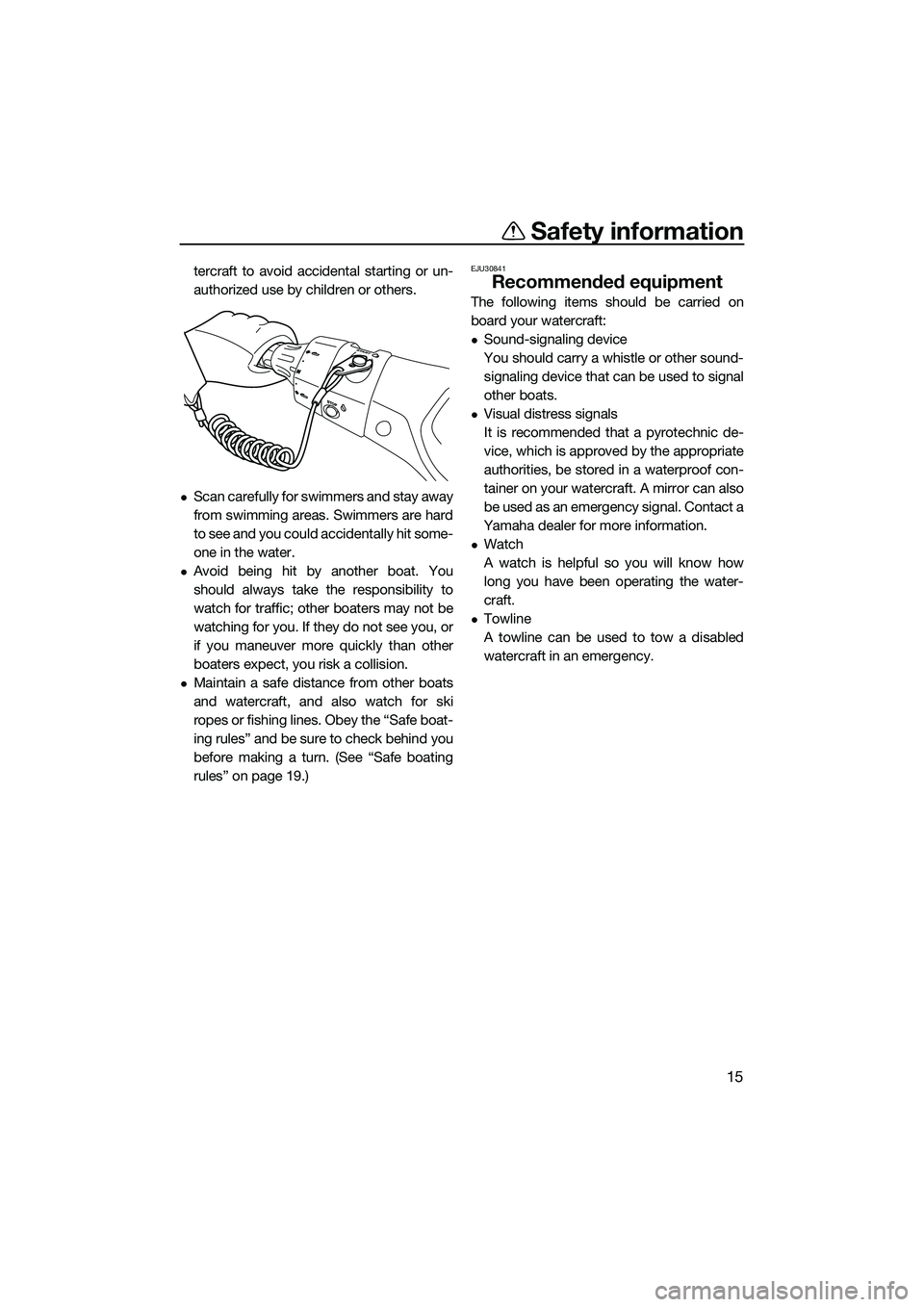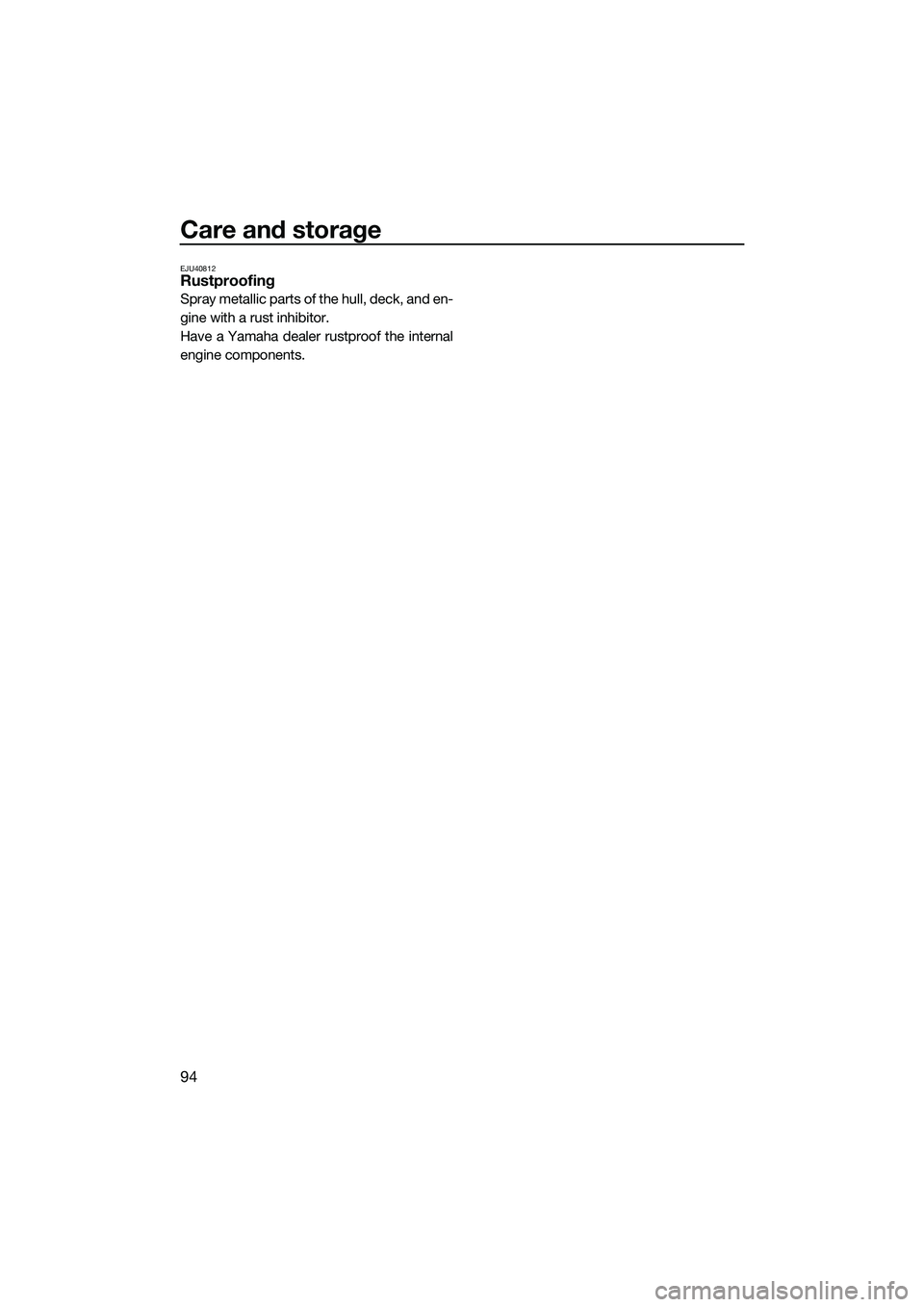2014 YAMAHA FX SVHO roof
[x] Cancel search: roofPage 6 of 118

Table of contents
Transporting on a trailer ................ 63
First-time operation ........................ 64 Engine break-in ............................. 64
Pre-operation checks ..................... 65
Pre-operation checklist .................... 65
Pre-operation check points........... 67
Pre-launch checks ........................... 67
Post-launch checks ......................... 74
Operation ......................................... 76 Operating your watercraft ............. 76
Getting to know your watercraft ...... 76
Learning to operate your
watercraft ...................................... 76
Riding position ................................. 77
Launching the watercraft ................. 77
Starting the engine on water ............ 77
Stopping the engine ......................... 78
Leaving the watercraft...................... 78
Operating the watercraft .................. 78
Turning the watercraft ...................... 79
Stopping the watercraft ................... 80
Operating the watercraft in reverse or neutral....................................... 81
Boarding the watercraft ................... 82
Starting off........................................ 85
Capsized watercraft ......................... 86
Beaching and docking the
watercraft ...................................... 87
Operating in weeded areas .............. 87
After removing the watercraft from the water ....................................... 88
Care and storage............................. 89Post-operation care ...................... 89
Flushing the cooling water
passages....................................... 89
Cleaning the watercraft .................... 90
Battery care ...................................... 90
Long-term storage ........................ 93
Cleaning ........................................... 93
Lubrication ....................................... 93 Rustproofing ..................................... 94
Maintenance .................................... 95
Maintenance ................................. 95
Tool kit.............................................. 95
Removing and installing the engine
cover ............................................. 95
Periodic maintenance chart ............. 97
Engine oil and oil filter ...................... 99
Specifications ................................ 100 Specifications ............................. 100
Trouble recovery ........................... 101 Troubleshooting .......................... 101
Troubleshooting chart .................... 101
Emergency procedures .............. 104
Cleaning the jet intake and
impeller ....................................... 104
Jumping the battery ....................... 105
Replacing the fuses ........................ 105
Replacing the bilge pump fuse ...... 107
Towing the watercraft..................... 108
Submerged watercraft ................... 109
UF3J70E0.book Page 2 Wednesd ay, October 9, 2013 2:07 PM
Page 21 of 118

Safety information
15
tercraft to avoid accidental starting or un-
authorized use by children or others.
Scan carefully for swimmers and stay away
from swimming areas. Swimmers are hard
to see and you could accidentally hit some-
one in the water.
Avoid being hit by another boat. You
should always take the responsibility to
watch for traffic; other boaters may not be
watching for you. If they do not see you, or
if you maneuver more quickly than other
boaters expect, you risk a collision.
Maintain a safe distance from other boats
and watercraft, and also watch for ski
ropes or fishing lines. Obey the “Safe boat-
ing rules” and be sure to check behind you
before making a turn. (See “Safe boating
rules” on page 19.)
EJU30841
Recommended equipment
The following items should be carried on
board your watercraft:
Sound-signaling device
You should carry a whistle or other sound-
signaling device that can be used to signal
other boats.
Visual distress signals
It is recommended that a pyrotechnic de-
vice, which is approved by the appropriate
authorities, be stored in a waterproof con-
tainer on your watercraft. A mirror can also
be used as an emergency signal. Contact a
Yamaha dealer for more information.
Watch
A watch is helpful so you will know how
long you have been operating the water-
craft.
Towline
A towline can be used to tow a disabled
watercraft in an emergency.
UF3J70E0.book Page 15 Wednesd ay, October 9, 2013 2:07 PM
Page 32 of 118

Control function operation
26
EJU31025
Watercraft control functionsEJU42551Remote control transmitter
The Yamaha Security System and Low RPM
Mode settings can be selected by operating
the remote control transmitter. (See page 27
for Yamaha Security System setting proce-
dures and page 35 for Low RPM Mode acti-
vation procedures.)
Since the watercraft is programmed to rec-
ognize the internal code from this transmitter
only, the settings can only be selected with
this transmitter.
If you accidentally lose your remote control
transmitter or if it is not operating properly,
contact a Yamaha dealer.
When operating the watercraft, always keep
the transmitter with you, such as by storing it
in the transmitter holder in the built-in water-tight storage compartment, so that it is not
lost.
NOTICE
ECJ00753
The remote control transmitter is not
completely waterproof. Do not sub-
merge the transmitter or operate it un-
derwater. If the transmitter is
submerged, dry it with a soft, dry cloth,
and then check that it is operating prop-
erly. If the transmitter is not operating
properly, contact a Yamaha dealer.
Keep the remote control transmitter
away from high temperatures and do
not place it in direct sunlight.
Do not drop the remote control trans-
mitter, subject it to strong shocks, or
place any heavy items on it.
Use a soft, dry cloth to clean the remote
control transmitter. Do not use deter-
gent, alcohol, or other chemicals.
Do not attempt to disassemble the re-
mote control transmitter yourself. Oth-
erwise, the transmitter may not operate
properly. If the transmitter needs a new
battery, contact a Yamaha dealer. Refer
to local hazardous waste regulations
when disposing of transmitter batteries.
1
Remote control transmitter
1Transmitter holder
1
UF3J70E0.book Page 26 Wednesd ay, October 9, 2013 2:07 PM
Page 58 of 118
![YAMAHA FX SVHO 2014 Owners Manual Equipment operation
52
cleat breaks, the watercraft could fall,
which could result in severe injury.
[EWJ01511]
EJU34893
Pull-up cleats (FX Cruiser SVHO)
The pull-up cleats are used to attach a rope
YAMAHA FX SVHO 2014 Owners Manual Equipment operation
52
cleat breaks, the watercraft could fall,
which could result in severe injury.
[EWJ01511]
EJU34893
Pull-up cleats (FX Cruiser SVHO)
The pull-up cleats are used to attach a rope](/manual-img/51/49923/w960_49923-57.png)
Equipment operation
52
cleat breaks, the watercraft could fall,
which could result in severe injury.
[EWJ01511]
EJU34893
Pull-up cleats (FX Cruiser SVHO)
The pull-up cleats are used to attach a rope
to the watercraft when mooring it.
To use a pull-up cleat, pull it up. The pull-up
cleat returns automatically to its original posi-
tion when released. WARNING! Do not use
the pull-up cleats to lift the watercraft. The
pull-up cleats are not designed to support
the watercraft’s weight. If the pull-up
cleats break, the watercraft could fall,
which could result in severe injury.
[EWJ00822]
EJU42291
Storage compartments
This watercraft is equipped with the following
storage compartments.
Only the securely closed watertight storage
compartments are waterproof. If you carry objects that must be kept dry, put them in a
waterproof bag.
Make sure that the storage compartments
are closed securely before operating the wa-
tercraft.
EJU42211Bow storage compartment
The bow storage compartment is located un-
der the hood.
To open the bow storage compartment:
Pull the hood latch rearward, and then lift up
the rear of the hood.
1
Cleat
1 Pull-up cleat
1
1
1Hood latch
1 Bow storage compartment
Bow storage compartment:
Capacity: 90.0 L (23.8 US gal, 19.8 Imp.gal)
Load limit:
5.0 kg (11 lb)
1
1
UF3J70E0.book Page 52 Wednesd ay, October 9, 2013 2:07 PM
Page 100 of 118

Care and storage
94
EJU40812Rustproofing
Spray metallic parts of the hull, deck, and en-
gine with a rust inhibitor.
Have a Yamaha dealer rustproof the internal
engine components.
UF3J70E0.book Page 94 Wednesday, October 9, 2013 2:07 PM
Page 101 of 118

Maintenance
95
EJU33769
Maintenance
Periodic checks and lubrication will keep
your watercraft in the safest and most effi-
cient condition possible. Therefore, make
sure to carry out the periodic maintenance.
Safety is an obligation of the watercraft own-
er. Proper maintenance must be carried out
to keep the exhaust emission and sound lev-
els within the regulated limits. The most im-
portant points of watercraft inspection and
lubrication are explained on the following
pages.
See a Yamaha dealer for genuine Yamaha re-
placement parts and optional accessories
designed for your watercraft.
Remember, failures that are the result of the
installation of parts or accessories which are
not qualitatively equivalent to genuine
Yamaha parts are not covered by the limited warranty.
Maintenance, replacement, or repair of
the emission control devices and system
may be performed by any marine SI engine
repair establishment or individual. War-
ranty repair, however, must be performed
at an authorized Yamaha marine dealer-
ship.
WARNING
EWJ00312
Be sure to turn off the engine when you
perform maintenance unless otherwise
specified. If you are not familiar with ma-
chine servicing, this work should be done
by a Yamaha dealer or other qualified me-
chanic.
EJU33803Tool kit
A tool kit is included with this watercraft.
Place the tool kit in a waterproof bag and al- ways carry it with you whenever you use the
watercraft.
EJU42021Removing and installing the engine
cover
The engine cover is removable.
To remove the engine cover:
(1) Remove the seats. (See page 49 for seat
removal and installation procedures.)
(2) Remove the engine cover screws.
1 Tool bag
2 Screwdriver
3 Garden hose adapter
4 10/12 mm box wrench
5 Pliers
6 10/12 mm open-end wrench
1 Engine cover screw
1
UF3J70E0.book Page 95 Wednesd ay, October 9, 2013 2:07 PM
Page 117 of 118

Index
Learning to operate your watercraft ........ 76
Leaving the watercraft ............................. 78
Limitations on who may operate the watercraft.............................................. 11
Long-term storage ................................... 93
Low RPM Mode ....................................... 35
Lubrication ............................................... 93
M
Main components, location of ................. 22
Maintenance ............................................ 95
Manufactured date label ............................ 2
Model information ...................................... 2
Multifunction display (FX Cruiser SVHO) ................................................... 45
Multifunction information center .............. 40
Multifunction information center check ... 75
N
No-wake mode ........................................ 36
O
Oil pressure warning ................................ 44
Operating in weeded areas ...................... 87
Operating the watercraft .......................... 78
Operating the watercraft in reverse or neutral ................................................... 81
Operating your watercraft ........................ 76
Operation requirements ........................... 13
P
Periodic maintenance chart ..................... 97
Post-launch checks ................................. 74
Post-operation care ................................. 89
Pre-launch checks ................................... 67
Pre-operation check points ..................... 67
Pre-operation checklist ............................ 65
Primary Identification (PRI-ID) number ...... 1
Pull-up cleats (FX Cruiser SVHO)............. 52
Q
Quick Shift Trim System (Q.S.T.S.) .......... 33
Quick Shift Trim System (Q.S.T.S.) checks .................................................. 70
R
Reboarding grip ....................................... 50
Reboarding step ...................................... 50
Recommended equipment ...................... 15
Remote control transmitter ...................... 26
Remote control transmitter check ........... 72 Riding position ......................................... 77
Rustproofing ............................................ 94
S
Safe boating rules .................................... 19
Safety equipment check .......................... 73
Seats ........................................................ 49
Shift system ............................................. 32
Shift system checks ................................. 71
Start switch .............................................. 28
Starting off ............................................... 85
Starting off from a trailer .......................... 86
Starting the engine on water .................... 77
Steering system ....................................... 29
Steering system checks ........................... 69
Stern drain plug checks ........................... 73
Stern eyes ................................................ 51
Stern storage compartment ..................... 54
Stopping the engine ................................. 78
Stopping the watercraft ........................... 80
Storage compartment checks.................. 72
Storage compartments ............................ 52
Submerged watercraft ........................... 109
Switch checks .......................................... 72
T
Throttle lever ............................................ 29
Throttle lever checks ................................ 71
Tool kit ..................................................... 95
Towing the watercraft ............................ 108
Transporting on a trailer ........................... 63
Troubleshooting ..................................... 101
Troubleshooting chart ............................ 101
Turning the watercraft .............................. 79
W
Water separator ....................................... 31
Water separator check ............................. 68
Watercraft characteristics ........................ 16
Watercraft control functions..................... 26
Watercraft operation functions ................ 32
Watercraft operation modes .................... 35
Water-skiing ............................................. 18
Watertight storage compartments ........... 55
Y
Yamaha Security System ......................... 27
Yamaha Security System settings ........... 27
UF3J70E0.book Page 2 Wednesd
ay, October 9, 2013 2:07 PM